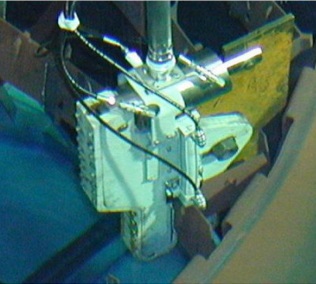Westinghouse set for 3D, scaling savings in six-reactor dismantling deal
New 3D models will accelerate the dismantling and packaging of Unterweser reactor internals and learnings will be rolled out across five other upcoming projects in Germany, project partners GNS and Westinghouse, told Nuclear Energy Insider.

Related Articles
In February, E.ON subsidiary PreussenElektra was awarded the licence to decommission and demolish its 1.4 GW nuclear Unterweser nuclear power plant (KKU) in the state of Lower Saxony, north-west Germany.
The approval allowed PreussenElektra to start dismantling work on the first of six new German decommissioning projects planned in the next five years. The six plants include the shut-down KKU, Grafenrheinfeld, Isar 1 plants, and the operational Brokdorf, Grohnde and Isar 2 plants which are scheduled for closure in 2022.
For all six plants, the dismantling and packaging of RPV internals will be performed by Zerkon, a consortium led by Geselschaft Nuklear-Service (GNS) which includes Westinghouse's German and Swedish subsidiaries.
Westinghouse will be primarily responsible for the dismantling of reactor pressure vessel internals while GNS is responsible for waste packaging for final storage. In total, some 900 tons of plant material will be packed into around 1,100 casks and containers for final storage.
GNS and Westinghouse are currently using the latest 3-D modelling software to optimize the dismantling and packaging of reactor internals, the companies told Nuclear Energy Insider.
The partners will apply optimisation methods used on the KKU to perform simultaneous decommissioning work at the other five decommissioning projects when they come off-line in the coming years, Westinghouse experts said via email.
"A maximum of two plants will be dismantled in parallel...We will use lessons learned and optimizations between the projects to improve the site execution,” the experts said.
Growing demand
European decommissioning activity is on the rise as ageing fleets and energy policy shifts combine with stubbornly-low wholesale power prices. By 2020, some 150 European reactors will have reached a 40-year lifespan.
The German government's 2011 decision to close all 17 nuclear power plants by 2022 accelerated decommissioning activity. The total cost of decommissioning Germany's reactors is estimated at between 26 and 44 billion euros ($31-$53 billion), not including the procurement and construction of the country's first final waste repository, according to the government.
Estimated private company spending for Germany's nuclear clean-up
Source: Federal Ministry for the environment (BMU), 2015.
Rising European decommissioning activity represents opportunities for global nuclear firms looking to enter the market.
Last year, Jorg Klasen, Director of Decommissioning at German utility EnBW, warned the decommissioning services market was "short" for projects out to 2020.
ENBW owns five nuclear reactors and the company had already contracted all the critical suppliers for its planned decommissioning work from 2020 to 2025, Klasen told a conference in Manchester, UK.
Technology solutions
The segmentation of reactor internals is one of the most complex decommissioning tasks. Plant operators look to minimize the duration of fuel transfer and dismantling projects due to the high labor costs associated with monitoring and handling spent fuel and radioactive components.
Decommissioning companies are now applying the latest automation and visualization technologies to improve planning and gain greater accuracy in decommissioning work.
GNS and Westinghouse have used GNS' 3D modelling software ActiAtlas to optimize dismantling sequencing, clarify waste disposal requirements and determine component movement boundaries within the congested dismantled reactor vessel, Jorg Viermann, Head of Sales, Waste Department at GNS, said.
“Typically, there is not enough space inside the spent fuel ponds to store all cut components before packaging and not enough space in the reactor buildings for all produced packages,” Viermann said.
"Therefore there has to be an alternating works scheme of cutting and packaging, with packages having to be removed from the reactor building after some intitial treatment and checks,“ he said.
By using the software to map out the varying radition levels across the RPV components and minimize overly conservative assumptions, the project partners were able to determine "optimum tool development, cutting methods and packaging configurations,“ Westinghouse experts told Nuclear Energy Insider.
GNS and Westinghouse first used the software on the decommissioning of ENBW's 926 MW Philippsburg 1 BWR plant. The two companies are also collaborating on EnBW’s 840 MW Neckarwestheim-1 plant (GKN 1), where "cutting work is well underway," Viermann said.
Germany's operational nuclear power plants
(Click image to enlarge)

Source: World Nuclear Association (April 2018)
Cutting strategies
For KKU and the subsequent five PreussenElektra projects, Westinghouse plans to use proven mechanical cutting techniques used on its completed Belgium Reactor 3 and Spain's Jose Cabrera decommissioning projects, as well as the Philippsburg 1 and Neckarwestheim 1 projects in Germany.
Nuclear industry cutting techniques could evolve in the coming years. A recent study by the U.S. Electric Power Research Institute (EPRI) found that deployment of thermal arc saw cutting, underwater lasers and self-operating systems could shorten reactor segmentation projects and cut costs.
According to Westinghouse, earlier decommissioning projects have shown that "overall project optimization is more important than "just focusing on the specific cutting speed,” company experts said.
The cutting time accounts for "approximately 25-30%" of the site activity time, they noted.
For waste packaging, the project partners will use GNS MOSAIK casks and steel sheet KonradContainers, Vierman said.
“Depending on the requirements at each site, we can either load into containers with a shielding that allows transport directly after loading or load higher activities into containers which...will not be transportable directly after loading,” he said.
The batch of six PreussenElektra plants set to be decommissioned in the coming years provides a major opportunity to apply the latest technology and scaling learnings to reduce decommissioning costs.
Such learnings will be welcomed by Europe's largest nuclear utilities, which continue to be pressured by sustained low wholesale prices and the rise of renewable energy and demand destruction technologies.
By Kerry Chamberlain

